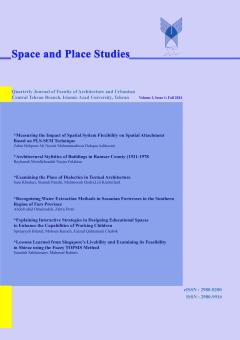Explaining Interactive Strategies in Designing Educational Spaces to Enhance the Capabilities of Working Children
Subject Areas : Environmental Design
ُSomaye Bitaraf
1
![]() ,
Mohsen Kameli
2
,
Farzad Qahremani Chabok
3
,
Mohsen Kameli
2
,
Farzad Qahremani Chabok
3
1 -
2 -
3 -
Keywords: Sense of Place, Empowerment, , Child Labor , Interactive Learning Space .Environmental Psychology ,
Abstract :
As is well recognized, mental health within the framework of social justice has emerged as a significant focus of research in recent years. This study aims to elucidate the physical and environmental factors influencing the design of educational and recreational spaces for child laborers, emphasizing the enhancement of their sense of belonging in communal areas through interactive learning strategies embedded within the community context. The concept of "sense of place," facilitated by effective learning techniques in architectural spaces—particularly in child-centric designs—plays a crucial role in fostering feelings of well-being, security, and satisfaction among children. Given that child laborers face more substantial psychological and social challenges compared to their peers and often lack the support of a healthy family environment, addressing this issue becomes even more critical. Accordingly, this research analyzes the impact of physical attributes such as form, texture, materials, spatial scale, and connection to nature on the sense of belonging experienced by child laborers within these environments. Studies indicate that environmental, social, cognitive, and motor components significantly influence these children's attachment to place. Therefore, appropriately designed educational spaces can enhance their sense of belonging, contribute to improved mental health, and assist in preparing them for integration into society and leading healthier lives.
ابراهیمی، ا.، طبقچی سالم، م. (۱۳۹۹). تأثیر فرم در معنای مکان آموزشی بر اساس نظریه وندر کلیس و کارستون (مطالعه موردی: مدارس شهر تبریز). نشریه هنرهای زیبا: معماری و شهرسازی، 25(3)، 51-60).
بیطرف، س.، نقدبیشی، ر. (1393). شناسههای ارتقاء امنیت مبتنی بر پایداری محیطی در طراحی قلمروهای عمومی. فصلنامه دانش انتظامی زنجان، 13(4)، 1-28.
فکوریان، ف.، حمزهنژاد، م. (1397). ساختمان دانشکده معماری، زمینه پرورش خلاقیت دانشجویان معماری. ابتکار و خلاقیت در علوم انسانی، 8(2)، 8-43.
حسینی، س. ح. (1384). وضعیت کودکان کار و خیابان در تهران. فصلنامه علمی پژوهشی رفاه اجتماعی، 9(5)، 155-174.
کاملنیا، ح.، حقیر، ا. (1388). الگوهای طراحی فضای سبز در «شهر دوستدار کودک» (نمونه موردی: شهر دوستدار کودک بم). هویت شهر، 6(12)، 77- 88.
لاهیجانیان، ا.، شیعهبیگی، ش. (1389). رویکردی تحلیلی به طراحی و مدیریت پارکهای شهری و رابطه آن با سلامت شهروندان، هویت شهر، 7(4)، 95-104.
معینی، م. م. (1385). افزایش قابلیت پیادهمداری، گامی به سوی شهری انسانیتر. نشریه هنرهای زیبا، 27، 5-16.
رهنما، م. ر.، ابراهیمی، ل. (1399). نقش رضایت شهروندان بر رفتارهای مثبت شهروندی (مطالعه موردی: شهر مشهد)، پژوهشهای جغرافیای انسانی، 52(1)، 39-54.
سجادی قائممقامی، پ. س.، پوردیهیمی، ش.، ضرغامی، ا. (1389). اصول پایداری اجتماعی در مجتمعهای مسکونی از دید جامعه صاحبنظران و متخصصان ایرانی. صفه، 20(51)، 75-87.
شرقی، ع. (1390). تأثیر کیفیت معماری منظر پردیس دانشگاهی بر کاربرد آموزشی آن؛ تحلیل کارکردی نظریه بازسازی تمرکز ذهنی و مطالعه دانشجویان در فضای باز. هنرهای زیبا، 8(18)، 51-62.
شفائی، م. (1388). طراحی فضاهای آموزشی برای کودکان 3 تا 6 سال با توجه به افزایش خلاقیت آنها در ایران. تز دکترای معماری، دانشگاه علم و صنعت ایران.
شفیعی، ش.، دیدهبان، م. (1395). بررسی نقش فضای معماری در ایجاد حس امنیت (نمونه موردی: طراحی فضای اقامتی کودکان کار). در دومین کنفرانس بینالمللی نخبگان عمران، معماری و شهرسازی، لندن، انگلستان.
اسمیت، ر. (1390). مدیریت کارآمد در کلاس درس (ز. صباغیان، مترجم). تهران: انتشارات صابرین.
یوسفی، س. (1396). اصول طراحی مجموعه اقامتی برای کودکان بیسرپرست (با رویکرد اجتماعی). تهران: انتشارات طحان.
وینهاوس، د. (1402). کلیدهای کشف و پرورش استعداد کودکان (ا. قیاسی، مترجم). تهران: انتشارات صابرین.
عظمتی، ح. ر.، پرویزی، ر.، کریمی آذری، ا. ر.، آقابیگی کلاکی، م. (1395). اصول طراحی مؤثر در ارتقا خلاقیت دانشآموزان در فضای آموزشی (نمونه موردی: دبیرستانهای دخترانه لاهیجان). ابتکار و خلاقیت در علوم انسانی، 6(2)، 121-142.
playgrounds on children's achievements. Naqshejahan - Studies in Theoretical and New Technologies of Architecture and
Urbanism, 9(2), 125–134. Hashem Lou, J. (2014). Nazarīye-ye moḥīṭ-garāyi-ye Jān Lāk. Retrieved from https://jafarhashemlou.blogfa.com/post/694 Rajaei Bahabadi, M. (2024). Ta'sīr-e moḥīṭ-e āmūzeshī bar salāmat-e ravān-e kudakān dar madāres-e ebtedā'ī. Retrieved from https://civilica.com/doc/2137351


